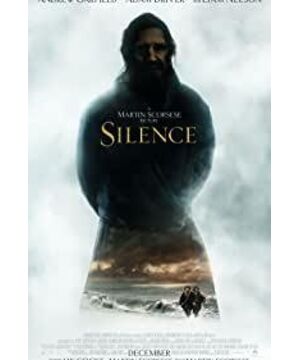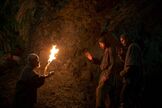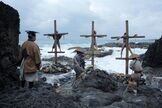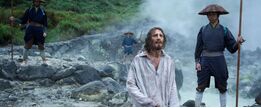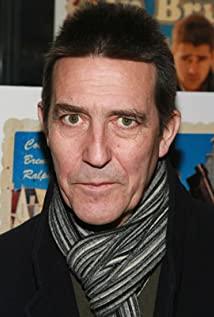The film is based on Endo Shusaku's novel of the same name and tells a story that happened more than 300 years ago. In the middle of the 16th century, Catholicism began to be introduced to Japan, and in just 30 years, it has grown to 150,000 believers. In 1613, Tokugawa Ieyasu promulgated a ban on Catholicism, and Shigemasa Matsukura, the lord of the Shimabara domain on Kyushu Island, began a bloody suppression of Catholics. He invented all kinds of punishment to torture and execute missionaries and believers. Among them is a kind of horrific torture called "hanging a hole", that is, a deep pit is dug, the victim is hanged upside down, his head is placed in the pit, the neck is locked with a yoke, and a slit is made behind the ear. Blood would slowly drip from the wound into the pit, and the prisoner would cry in the hole for days before the blood dried up and died.
The story begins when the church receives a letter from Father Ferreira, in which the staunch missionary recounts the appalling religious persecution he experienced in Shimabara, Japan. Since then, he has lost contact with the church, and there are rumors that he is still alive, but has betrayed his faith, and even publicly denigrated Catholicism, becoming an "anti" missionary. The priest's students, young missionary Rodriguez and Calbe, decided it was a rumor, and they volunteered to go to Japan to find out his whereabouts and to find out the truth of his "apostasy". They found a drunken Japanese Yoshijiro as a guide in a tavern, sneaked to Japan, and then embarked on a dangerous missionary journey.
The film does not explicitly reveal the time of the story, but it can be seen that it happened after the Shimabara Rebellion (a peasant uprising launched by the Shimabara and Amakusa Catholics in 1638). Because the protagonist Rodriguez was not subjected to the legendary torture after his arrest, officials treated him with courtesy. On the day of his arrest, he thought he was going to die, but an old white-haired man who looked like he couldn't bear to be trampled to death walked up to him tremblingly and gently persuaded Rodriguez to publicly renounce his faith. Rodriguez asked unceremoniously: If I don't convert, will you torture me and execute me? The old man didn't bother him at all. He shook his head with a smile and said, "We have learned our lesson. Killing believers and priests will only make the problem worse. If they have the opportunity to die for their gods, they will become worse. Be strong." In the prison cell of the government, he longed to see the murderer Inoue Tsukomeu, who had become disgusted by the believers, and he wanted to confront him, and then be tortured to death and become a glorious martyr. But the officials just sat down with him and told him that Catholicism was not suitable for Japan. He was in a hurry, and he shouted excitedly: If you want to test my faith, give me a real challenge, take me to see Master Inoue (let me be tortured)! To his surprise, the officials looked at each other and finally burst out laughing. Rodriguez didn't know that the smiling, polite old man sitting in front of him, the wise man who had been patiently reasoning with him since we met, was the devil Inoue-sama he imagined.
Behind Inoue's amiable face, Rodriguez saw with his own eyes the cruel and terrifying side of the incident: he saw the suffering and perseverance of the Japanese believers, and he was moved by their extreme desire to bathe in the gospel. The villagers sacrificed their heads to worship him, follow him, and trust him. He witnessed the village chief grandfather, Ji Mao and another unknown church member willing to sacrifice their lives to protect him, tied to a cross by the sea and beaten by the waves until they died; he saw a man who gave himself a Christian name" John's followers were beheaded for refusing to trample on icons - just as happened to "John the Baptist". He saw the villagers who were unwilling to abandon their religion being rolled up in mats and pushed into the sea one by one, and his colleague Calbe drowned in vain trying to save them. The translator kept saying in his ear: Tragedy, Tragedy! You know, these people died because of your vanity. In the middle of the night, the missionary prayed bitterly in the cell: God, why did you abandon me? Have you ever given such cruel silence to your children? And God's answer was to let him meet Father Ferreira, the mentor he used to worship, a strange man wearing a Japanese kimono, with a Japanese name, a Japanese wife and a Japanese son, and persuaded him to stop sticking to his beliefs. Finally, Ferreira took him to the execution ground, where five devotees were being tortured in the "hanging hole", their bodies suspended in cloth bags, shaking like cramps, their heads buried in the ground, emanating from the cave Howling all night. He was asked to perform "step painting"—a method invented by Mizuno to identify Catholics: placing a copper plate inscribed with an icon in front of the subject and forcing him to trample on it. The interpreter persuaded him again in his ear: If you are a good priest, step on it, even if it is a formality, and you can end the punishment of these people. Missionaries are tormented by a difficult choice between sacred faith and minimal humanity. Just then, he heard the Son of Man speaking to him on the copper plate:
Step on! Get on it! I know the pain in your feet best. Get on it! I came to this world just to be trampled on by you, and to bear the cross to share your pain.
So he stepped down. So he became "Paul the Apostate."
"Paul the Apostate" is another person who has completely abandoned missionary ideas and has never said or done anything to reveal that he was a believer. Like his teacher Ferreira, he inherited the name, wife and children of a dead Japanese nobleman and became a thoroughly Japanese. He tried his best to search various religious tokens for the lord and write articles critical of religion. He is still required to do "step painting" on a regular basis. He was constantly under the watchful eye of the officers, doing whatever they asked. But has he really given up religion in his heart? No one knows. In this way, he spent a silent life in Japan, and held a funeral according to Japanese customs. His body was put into a wooden barrel under the care of an official, and sat in the barrel like a monk, ready to be cremated. His Japanese wife was allowed to stuff a white paper-wrapped razor into his hand as the only memento of his earthly walk.
The above story illustrates the conflicting values of faith and human nature brilliantly and profoundly, but that's not what moved me the most. As I think more deeply, I feel that this film is not so much a religious film as it is a philosophical film. In the film, the part of "tread painting" appears repeatedly. The protagonist was not physically tortured after his arrest. The officials only asked him to do a public tread painting, which made all the tragic power of the story infused into the film. In this seemingly simple action. Therefore, "step painting" has acquired a strong symbolic meaning and paradox color - only by denying religion can you truly fulfill religion. The protagonist's trampling on the icon is also trampling on his own identity. It also symbolizes the conflict and fusion of two different cultures. The icon represents the common misunderstanding of Catholicism by the Japanese, and the trampling on the icon not only has the concept of self-sacrifice and redemption in Christian culture, but also includes the concept of Buddhism in Buddhism. Destroy the attitude of obsession. In the thinking of the Eastern peoples, the truth can only be understood through "abandonment". True wisdom is an intangible thing. As the saying goes, "The law should be abandoned, how much more is it illegal?" Therefore, there are two completely different ways of transcendence in Eastern and Western cultures. The ground merged into the action of tread painting.
Rodriguez finally agreed to do the drawing, partly because of his sympathy for the suffering believers, and partly because he finally understood the teaching of his teacher Frederick that the Japanese could not truly understand Catholicism. When he first arrived in Japan, he was moved by the piety and steadfastness of Japanese believers, which led him to ignore the believers' distortion of doctrine, consciously or unintentionally. For example, he found that the villagers were very eager to get some religious souvenirs from him: crosses, rosary beads, idols, and treasured these objects as peace charms. On the day he was arrested, he felt that he was going to die, but a female believer beside him smiled at him, and he asked her: How can you be so calm? She asked: Can believers go to heaven after they die? Is it possible to have enough food every day in heaven, without military service, without paying taxes? When she got Rodriguez's hesitantly affirmative answer, she smiled even brighter, her face full of anticipation, like a child who was about to go on a trip. Heaven is not a transcendental shore for her, but just another earthly place, where people are still living, just better than in Japan. The guide Yoshijiro not only betrayed Rodriguez, but also apostates again and again under the threat of punishment. But every time he did bad things, he would come to the door to ask for repentance. He felt that after repenting, he would feel at ease, and he would no longer be responsible for the bad things he did, and the embrace of God would come to him again. open. Jijiro had a completely speculative attitude towards Catholicism, and even Rodriguez asked him helplessly: "Do you understand what repentance means?" When you worship, you will light incense when you see the temple, spend a few small coins to burn root incense, and throw a coin as merit money, in exchange for a lifetime of great wealth.
The film takes a neutral stance on the respective positions of both sides of the conflict - missionaries and Japanese officials. At the beginning, through the letters of Father Ferreira and the difficulty of the priests in their first arrival in Japan, the audience saw the cruelty of religious persecution in Japan, and then created an illusion that the Japanese rulers were demons and the priests were angels; But as the plot unfolds, people will find that the real situation is far more complicated than the letter. The officials are not vicious and unreasonable. On the contrary, most of them are well-spoken and well-bred, while the priest seems a little reckless and ignorant. Finally, Ferreira spoke to Rodriguez in the temple, clarifying a truth to the audience: on the surface, Catholicism in Japan was hindered because of the oppression of the lords, because of the apostasy of the missionaries, It's the simple story of evil over justice, but the underlying reason is that the Japanese simply don't believe in what Catholicism really claims, they believe in Catholicism distorted by their own ideas. They cannot comprehend any supernatural existence and can only accept things that have concrete images. The people of Japan cannot imagine abstract concepts such as original sin, the incarnation, and the trinity of an invisible God. Ferreira pointed to the sun in the sky and said to the young missionary: Look! They understood Jesus Christ as that!
So Inoue-sama said to the protagonist: We have learned our lesson. Officials represented by Inoue no longer torture missionaries, because missionaries are regarded as gods by the parishioners, and gods cannot be killed. He will be transferred from one body to another, and he will drink the blood of martyrs. Then get stronger and stronger. The only way is to turn God into a human being, and to make missionaries give up their religion in public. This is why Rodriguez did not suffer savage physical torture after his arrest, and when the officials in the movie carried out "step painting", they always persuaded believers: it doesn't matter, it's just a formality. "Form" is precisely the most important thing in the film. The power of form is so powerful that it transcends religion and meaning, power and torture. Form is the highest philosophy that precedes essence. The official said to the protagonist: We have carefully studied the teachings of your religion. Your religion is excellent in Spain and Portugal, but it is useless in Japan, and it will become a "dangerous thing". This "dangerous thing" he speaks of is form. In the eyes of officials, Japanese Buddhism is useful because Buddhism limits the exaggeration of form, and the idea of God's omnipotence preached by Catholicism makes form break free from its chains and become a monster that is no longer limited. As the translator in the film said to the protagonist: Buddhists let go of their delusions, but Catholics exaggerate their delusions infinitely.
The emergence of "monsters" is the result of cultural differences between the East and the West. Western culture is transmitted through sound and language, it is so-called "phonocentrism", so the focus of Catholicism is on the preaching of the formless, on listening to the teachings of Jesus, and on the other hand, the image or form in the concept of Westerners is Very low-level, what really makes sense is to abstract the idea from the form, and God is the highest representative of this idea. Therefore, Christianity strictly forbids idol worship. God cannot have a body. Christianity can infinitely exaggerate God's divine power, but this exaggeration will never obtain a certain material form in this world. In contrast, eastern culture is a kind of "symbol-centrism", and its highest wisdom is the silence of "big sound and sound", meditation and meditation, and the unfathomable comprehension of symbols in silence. meaning. Therefore, the eastern people attach importance to symbols, classics, spells, statues, and etiquette. Buddha is the representative of the highest wisdom, and the image of Buddha is everywhere. The Buddha statue is a symbol that represents the core of all meanings. Eastern nations attach great importance to etiquette, because etiquette is a symbol composed of the body - torture is also, and so is tread painting. There are subtleties, of course, beyond the comprehension of young Portuguese missionaries. The phonetics in "phonocentrism" and the symbols in "symbolism" are powerful meaning-generating mechanisms, and the combination of the two produces the "monster" mentioned above. (Comparing to the history of our modern China, this monster is not a completely unfamiliar animal!) Inoue changed the policy of killing and suppressing believers, and shifted the focus of work to instigating missionaries. He realized that the missionary, both as a living person and as a symbol, is the most dangerous being, the root of the whole problem, and only by deconstructing this symbol can we cut off the root cause. The people have an imitative nature to symbols, let the missionaries do apostasy, give them an example, and they will do the same, and the whole chain of faith will be disintegrated. This must be said to be the practice of deep understanding of the oriental national domination technique.
And "Paul the Apostate" is the opposite of the monster. In both the Western "phonetic centrism" and the Eastern "symbolic centrism", there are elements that suppress the excessive expansion of meaning, that is, the elimination of the shape and image of things in Western culture, and the vigilance of language and pronunciation in Eastern culture . In the cultural shock and collision, these two elements are attached to the protagonist at the same time, finally creating the most complete silence. He couldn't speak, couldn't write, couldn't show his inner faith in a single act, he couldn't pray to God anymore, he was forced to give up the magic of that prayer language and voice - the only bond between mortal and God; He can't even open his mouth to spread the gospel to those around him - it robs him of his power and makes him completely mortal. He was even asked to make various anti-religious gestures to denigrate his inner beliefs in public. He was defined as a fallen man, an apostate, and everything that could prove his beliefs, from his identity to his voice to his flesh, was completely stripped away. The only thing left is a lonely soul, holding on to a glimmer of faith in the endless black silence. How lonely it is! But it is this acceptance of silence and nothingness that allows the apostate to hear the voice of God in the deepest silence: it is through his silence and absence that God shows a man his eternal existence. At the end of the film, the camera passes through the barrel containing the missionary's body, through his rotten body and clenched palms, where, under that razor, the silent man holds a The crude cross was a gift given to him by fellow parishioner Ji Mao before he went to the execution ground.
Wednesday, April 12, 2017
View more about Silence reviews


